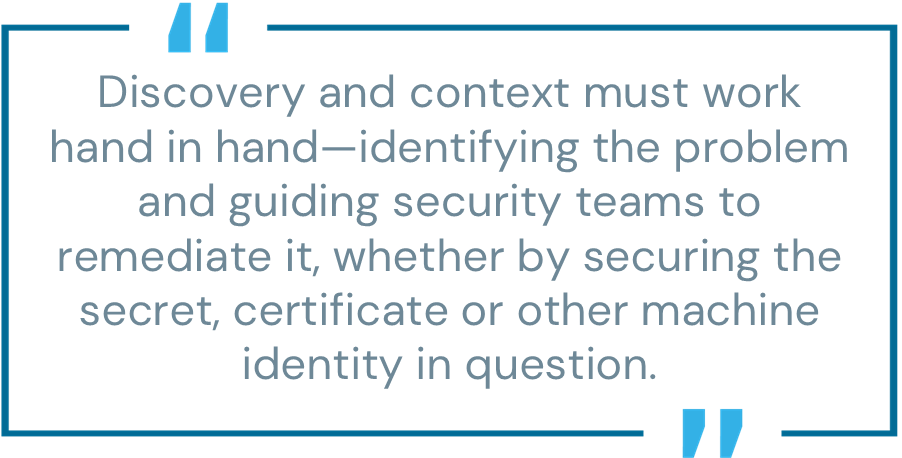
The digital landscape continues to undergo dramatic transformations. Long gone are the days when software, servers and infrastructure were monolithic and centralized. Today, organizations operate in a distributed and modular world, where machine identities are everywhere and environments are in various states of flux. AI and agentic AI are already starting to expand the volume and complexity of machine identities. This explosion in machine identities has opened up new attack paths, placing significantly increased demands on security teams, requiring advanced capabilities to discover machine identities and provide their context. These capabilities are crucial to making governance, lifecycle management and automation successful—and to measure improvement in reducing risk.
Future success in machine identity security hinges on expanding the discovery and context capabilities designed to help security teams discover, prioritize and eliminate risks tied to unprotected secrets, certificates and service accounts.
The Increasing Complexity of Modern IT Environments
Securing modern IT environments is an increasingly complex task. At the core of this complexity is the need to protect machine identities, including secrets and the service accounts they interact with, across the enterprise’s various technology stacks.
Secrets, API keys, access tokens and certificates—all facilitate secure machine-to-machine communication. However, without comprehensive visibility and context, security will struggle to prioritize and remediate risk, potentially leaving highly privileged machine identities unprotected and exposing opportunities for breaches and system downtime.
Understanding the context of how, why and where machine identities are used enables security teams to prioritize their efforts more effectively. Additionally, security teams can now measure and report improvements in risk reduction. As such, discovery and context are more important than ever.
Discovery without context too often proves to be overly broad and may just leave you with a random to-do list that doesn’t effectively prioritize remediation actions. Discovery and context must work hand in hand—identifying the problem and guiding security teams to remediate it, whether by securing the secret, certificate or other machine identity in question.

Why Discovery and Context Are Critical
Discovery tackles identifying all machine identities across an organization, including certificates, secrets (such as API keys and access tokens) and their associated service accounts in hybrid and multi-cloud environments.
Context goes further, providing insights into behaviors, risks and priorities, enabling security teams to take informed action and measure improvement. Together, discovery and context form the foundation of an effective machine identity security strategy, especially when combined with real-time risk management and remediation capabilities.
Simply put, discovery alone is not enough. When discovery efforts lack context and the ability to secure machine identities, it’s like finding problems—a lot of problems—but not knowing where to start and if the situation is getting better or worse.
Skyrocketing Growth—Evolving from Monolithic to Distributed Systems
To appreciate the necessity of discovery and context, it’s worth reflecting on how software and IT infrastructure previously functioned. IT systems were centralized. Consider the server rooms of just a decade ago, where machines were co-located in racks. Each rack might house five blades running 50 applications. A handful of identities could oversee and manage the entire infrastructure—typically assigned to authenticated administrators.
Fast-forward to today, and decentralized, distributed systems have shifted the paradigm entirely. Applications are now broken into microservices and hosted across on-premises servers, multiple cloud providers and Kubernetes clusters. Machines spin up and down within seconds, eliminating physical boundaries or consistent patterns. With decentralization comes a massive proliferation of machine identities, each requiring proper security, governance and monitoring.
Similarly, in cloud environments, the ease of creating secrets at scale has led to “vault sprawl.” Organizations deploy multiple isolated vaults to store critical secrets, too often maintaining copies of the same secret across multiple vaults and frequently without centralized oversight. Even when secrets are discovered, the service accounts they are tied to and how they are used often remain unclear.
This surge in machine identities has created an unprecedented need for centralized governance and visibility into all machine-to-machine interactions. Discovery and context together serve as the solution, addressing the risks and challenges associated with unmanaged identities and fragmented systems.
The Urgent Need for Discovery and Context
Security teams can’t prioritize or mitigate risks they don’t know exist. Without visibility and context, machine identity blind spots create serious vulnerabilities, including:
- Shadow identities: Undetected or untracked machine identities operate outside security policies, creating invisible risks.
- Expired and unknown certificates: Lapsed certificates cause costly outages and disrupt critical services and operations.
- Vault sprawl: Isolated vaults with unmanaged and unknown secrets make secrets rotation impractical because of the risk to operational continuity.
- Service account mismanagement: Multiple unmanaged service accounts compound security risks.
- Security gaps: Lack of visibility increases the risk of breaches caused by compromised or mismanaged identities.
- Operational inefficiency: Manual identity tracking is slow and prone to human errors, complicating security efforts.
Given these risks, organizations are increasingly prioritizing enhanced machine identity discovery and context capabilities as a critical initiative.
Key Initiatives for Machine Identity Security in 2025
Recognizing gaps in traditional approaches to discovery, leaders in machine identity security are rolling out powerful advancements that pair them with context, which allows them to prioritize the actions they can take with their limited resources and to measure improvement in risk reduction. Here are three key areas organizations can focus on to improve discovery, risk management, remediation and reporting:
1. Expanded Discovery and Inventory
Modern security programs require comprehensive machine identity discovery across hybrid and multi-cloud environments. Advanced tools will identify secrets, service accounts and certificates from sources like cloud vaults and Kubernetes environments.
More importantly, organizations want to be able to discover secrets and accounts from virtually any source—including APIs with rich metadata—dramatically enhancing visibility into their identity landscape. Centralized discovery will be foundational for mitigating risks and maintaining control over distributed systems.
2. Improved Risk Detection and Measurement
Discovery alone isn’t enough. To take informed action, organizations need advanced insights into machine identity risks, such as secret misuse or certificate expiration.
By introducing tools that provide well-rounded risk insights, security teams can filter, tag and manage identities with precision. These insights will allow teams to prioritize vulnerabilities and focus efforts on critical areas. The ability to accumulate contextual data across sources will be a game-changer in identifying and prioritizing hidden risks.
3. Mitigation and Remediation
Identifying risk is only one part of the equation; prioritizing and addressing it effectively is the challenge. Organizations need agile mitigation and remediation capabilities to act on identified risks efficiently.
For example, secrets can be securely onboarded and managed through platforms like the CyberArk Identity Security Platform. With real time remediation tools, teams can close security gaps before attackers exploit them.
The Future of Machine Identity Security
Discovery and context are no longer optional in the world of machine identity security—they are mission-critical. Securing secrets, certificates and service accounts becomes essential as IT infrastructures become increasingly distributed.
By enhancing discovery capabilities, providing actionable risk insights and enabling swift remediation, organizations can establish a solid foundation for securing the countless machine identities that power modern business operations. With context, security teams can measure, track and report their success in reducing the risk associated with the exploding growth in machine identities.
Navigating this complex landscape requires comprehensive tools and strategies. With increased discovery and centralized control, security teams can confidently secure machine identities at scale across enterprises’ diverse technology stacks. While the stakes are high, the right solutions make securing machine identities an achievable—and essential—goal.
Kevin Bocek is senior vice president of innovation at CyberArk.























